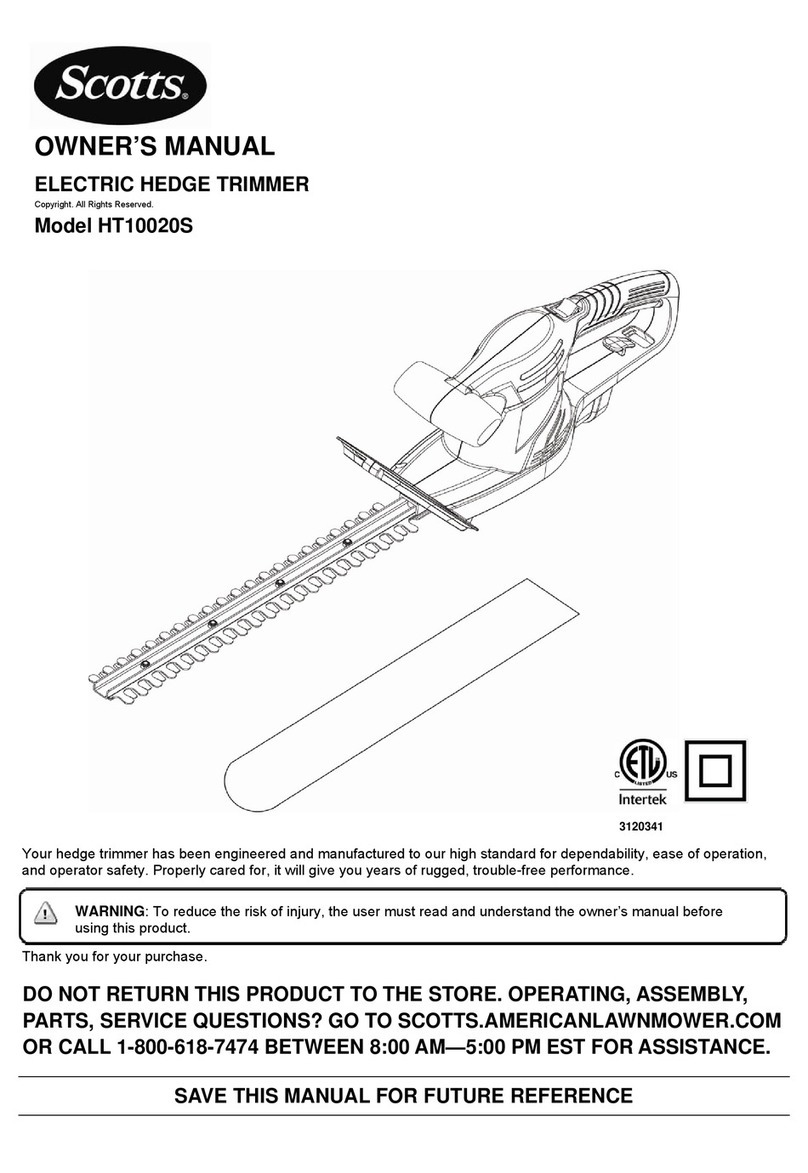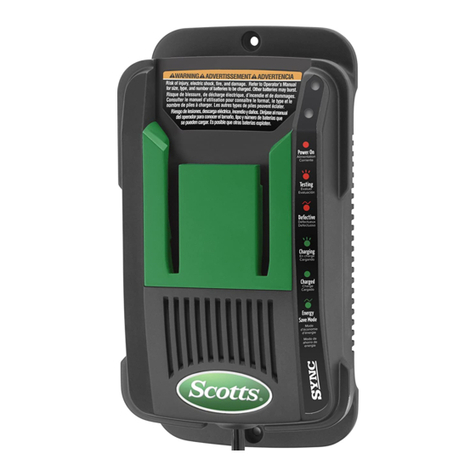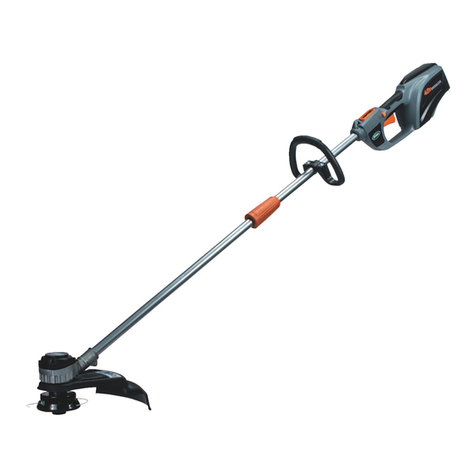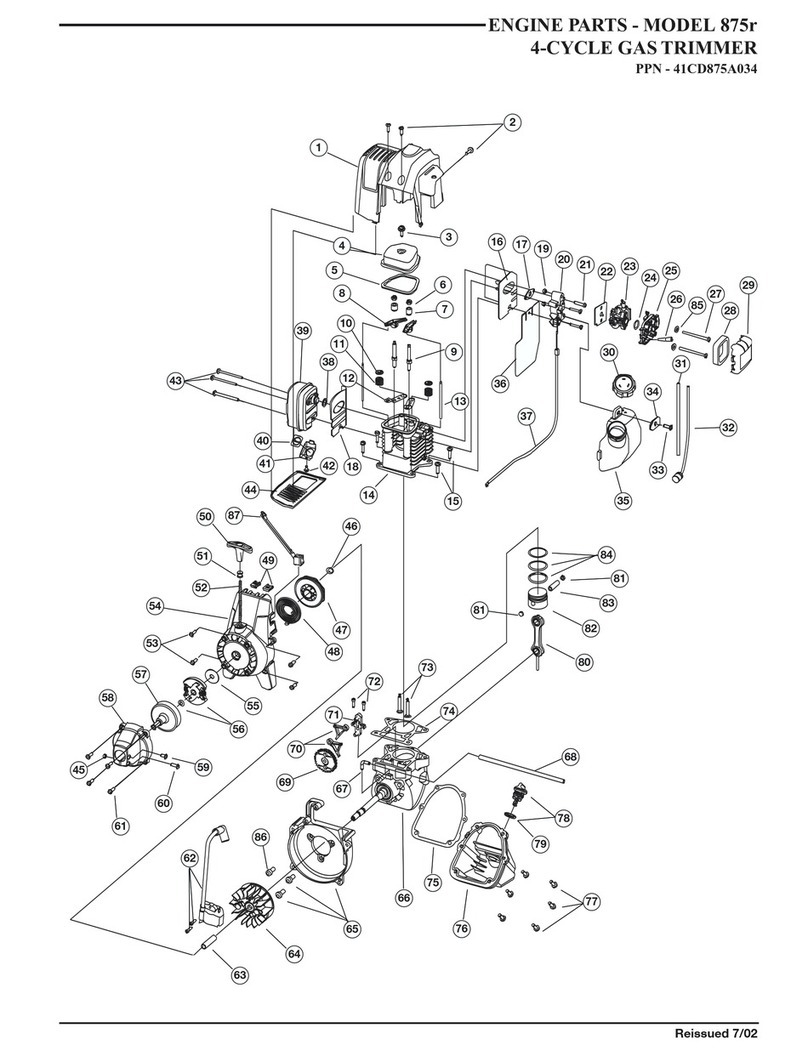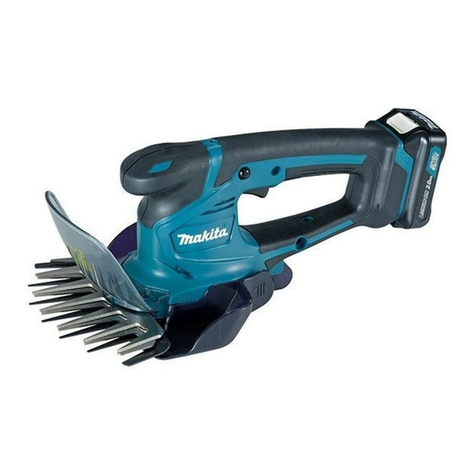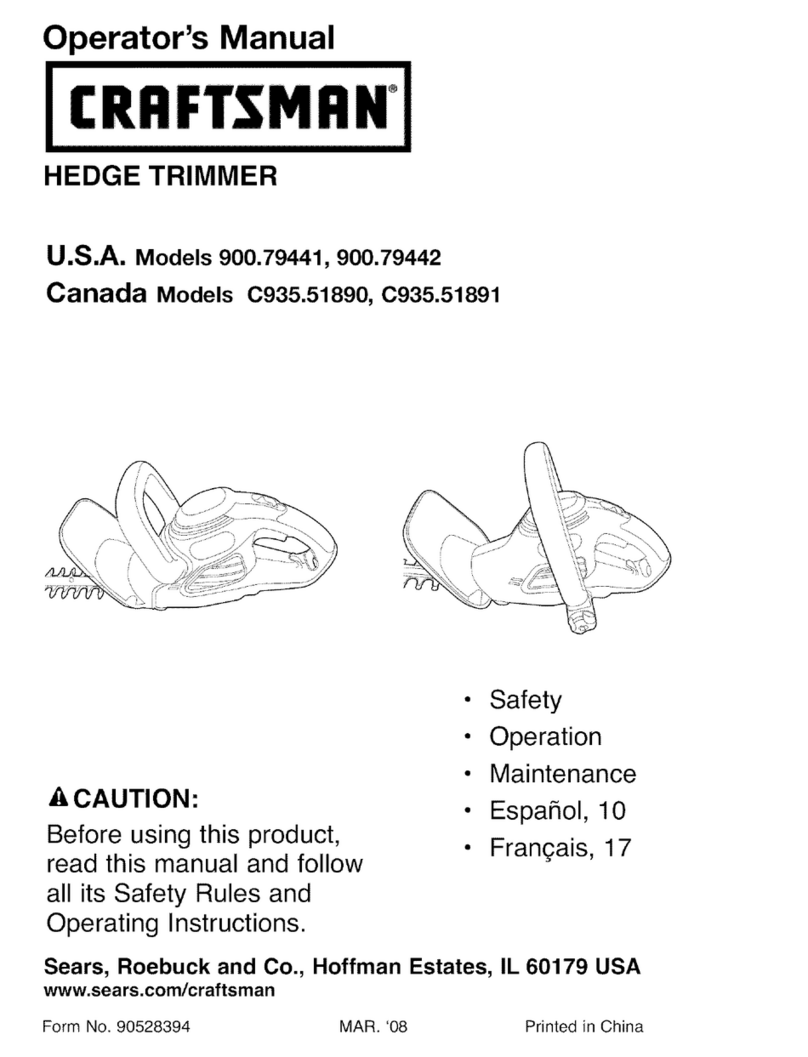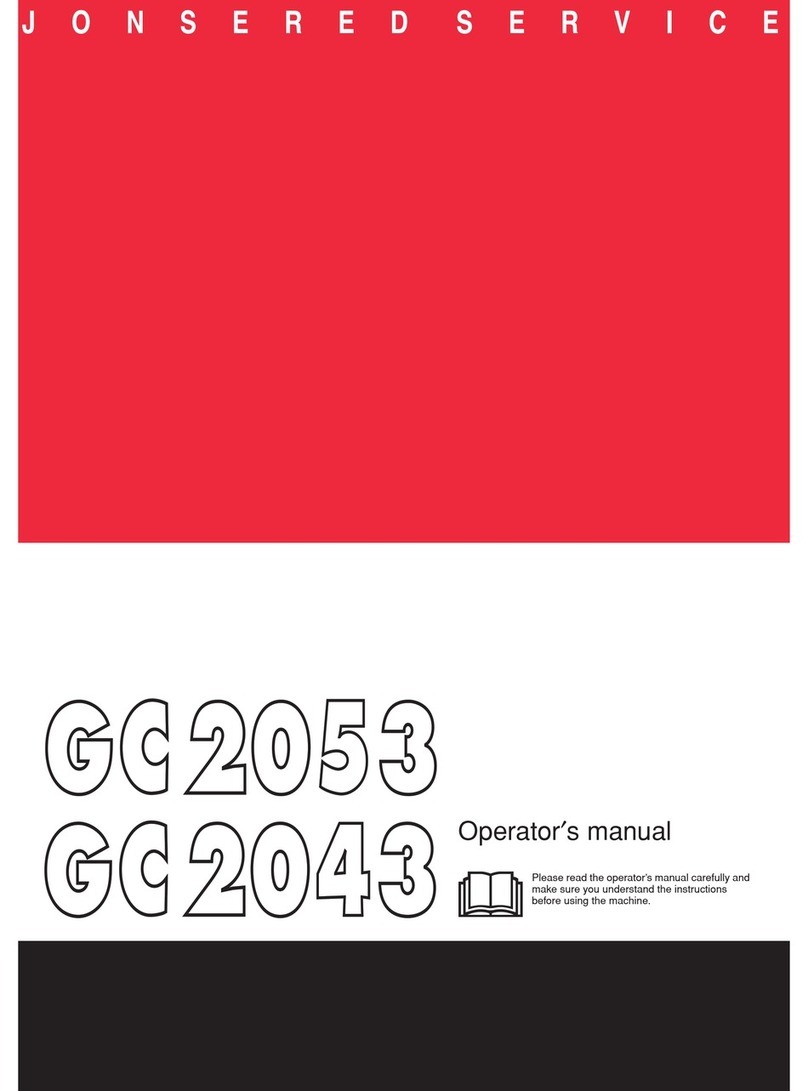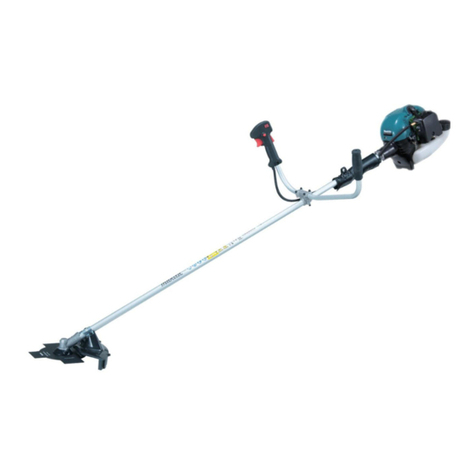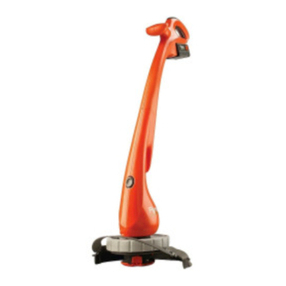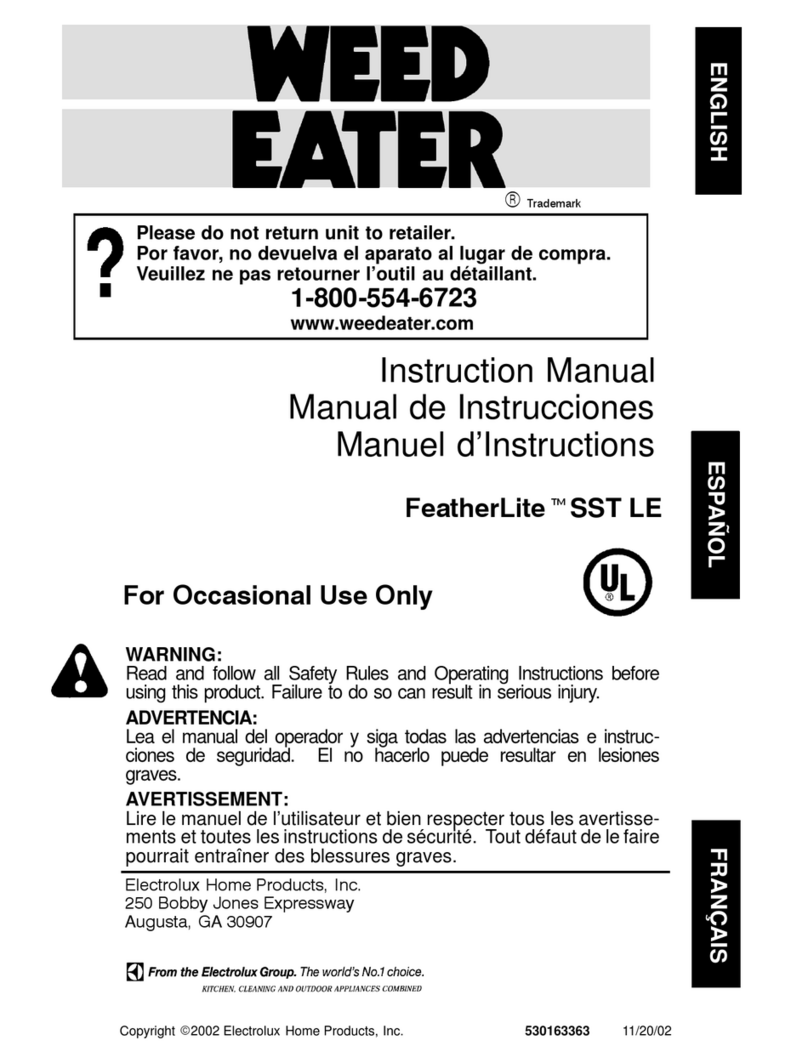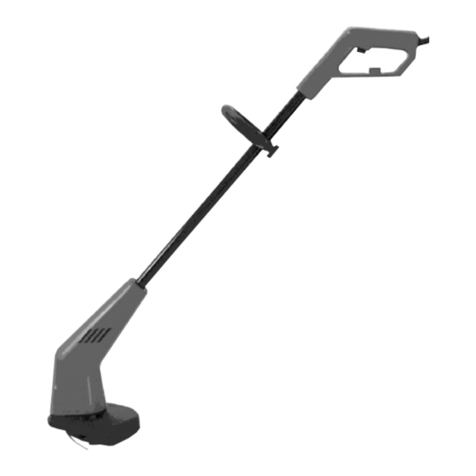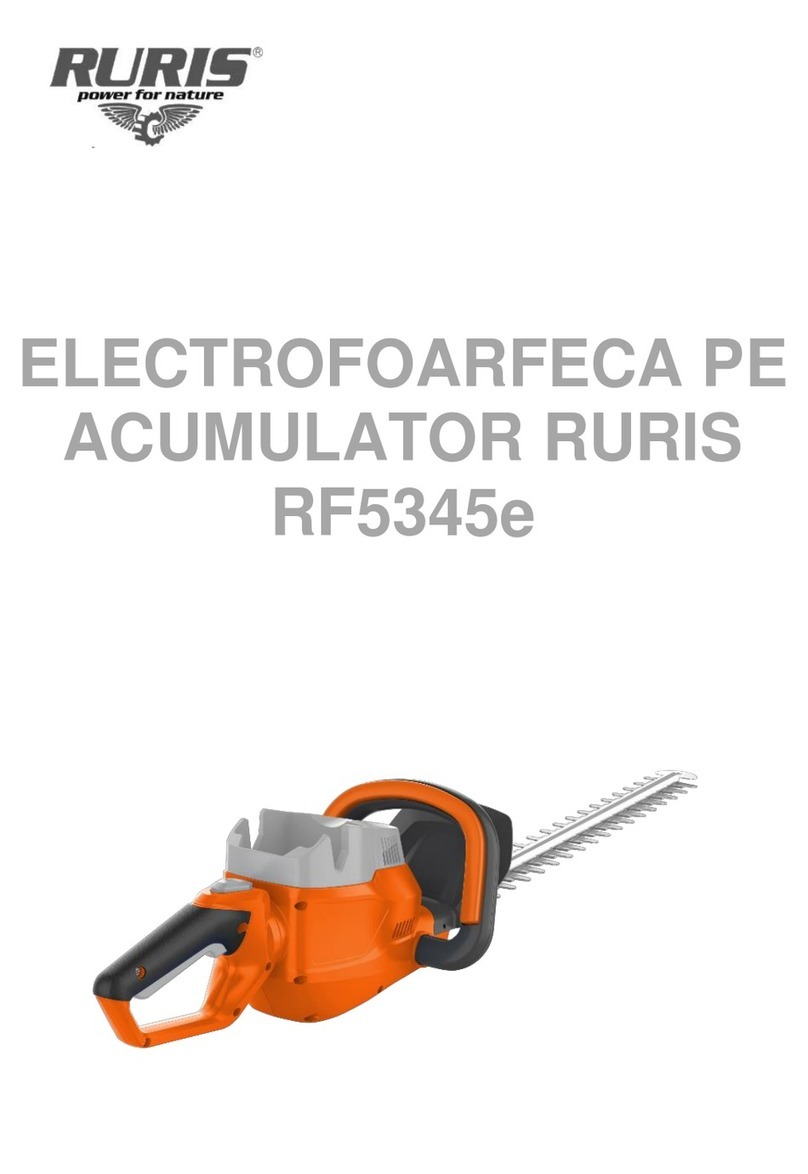Scotts S20200 User manual

S20200
20 Volt String Trimmer/Edger
Tondeuse à fouet/taille-bordure de 20 V
Recortadora de hilo/recortadora de bordes
de 20 V
OPERATOR’S MANUAL
MANUEL D’UTILISATION
MANUAL DEL OPERADOR
SAVE THIS MANUAL FOR
FUTURE REFERENCE
WARNING: To reduce the
risk of injury, the user must read and
understand the operator’s manual
before using this product.
ADVERTENCIA: Para reducir
elriesgodelesiones,elusuariodebeleer
y comprender el manual del operador
antes de usar este producto.
AVERTISSEMENT :
Pour
réduire les risques de blessures,
l’utilisateur doit lire et veiller à bien
comprendre le manuel d’utilisationavant
d’employer ce produit.
TABLE OF CONTENTS
****************
Important Safety Instructions............2-3
Symbols ...............................................4
Features ...............................................5
Assembly .............................................6
Operation ..........................................7-8
Maintenance ...................................9-10
Troubleshooting .................................10
Warranty.............................................11
Parts Ordering and
Service ................................. Back Page
TABLE DES MATIÈRES
****************
Instructions importantes
concernant la securite ....................2-3
Symboles ...........................................4
Caractéristiques.................................5
Assemblage .......................................6
Utilisation ........................................7-8
Entretien........................................9-10
Dépannage.......................................10
Garantie ...........................................11
Commande de pièces
et réparation......................Page arrière
ÍNDICE DE CONTENIDO
****************
Instrucciones de seguidad
importantes.................................... 2-3
Símbolos............................................4
Características...................................5
Armado..............................................6
Funcionamiento............................. 7-8
Mantenimiento............................. 9-10
Corrección de problemas ................10
Garantía ...........................................11
Pedidos de piezas
y servicio.......................Pág. posterior
CONSERVER CE MANUEL
POUR FUTURE RÉFÉRENCE
GUARDE ESTE MANUAL
PARA FUTURAS CONSULTAS
ACCEPTS ALL SCOTTS®20V BATTERY PACKS
BATTERIES AND CHARGERS SOLD SEPARATELY
COMPATIBLE AVEC TOUTES LE BLOC-PILES SCOTTS®DE 20 V
PILE ET CHARGEUR VENDUS SÉPARÉMENT
ACEPTA TODAS LOS PAQUETES DE BATERÍAS SCOTTS®DE 20 V
LAS BATERÍAS Y EL CARGADOR SE VENDEN POR SEPARADO

ii
See this fold-out section for all the figures
referenced in the operator’s manual.
Voir que cette section d’encart pour toutes les
figures a adressé dans le manuel d’utilisation.
Vea esta sección de la página desplegable para
todas las figuras mencionó en el manual del operador.
Fig. 1
A - Switch trigger and lock-out lever (gâchette
et levier de blocage, gatillo del interruptor y
palanca de seguro)
B - Trigger lock-out (verrouillage de la gâchette,
seguro del gatillo)
C - Battery fuel gauge (indicateur de niveau de
charge du bloc-piles, indicador de carga de
la batería)
D - Rotating rear handle (poignée arrière
rotative, mango delantero ajustable)
E - Adjustable front handle (poignée avant
réglable, mango delantero ajustable)
F - Telescoping shaft (arbre télescopique, brazo
telescópico)
G - Line cut-off blade (lame de sectionnement
de ligne, cuchilla de corte del hilo)
H - Grass defector (déflecteur d’herbe, deflector
de hierba)
A
Fig. 2
B
E
D
F
A - Trigger lock-out (verrouillage de la gâchette,
seguro del gatillo)
B - Switch trigger (gâchette, gatillo del
interruptor)
Fig. 5
H
B
A
Fig. 4
A - Latches (loquets, pestillos)
C
A - Grass deflector (déflecteur d’herbe, deflector
de hierba)
B - Trimmer head (tête de la tondeuse, cabezal
de la recortadora)
C - Line cut-off blade (lame de sectionnement
de ligne, cuchilla de corte del hilo)
D - Screws (vis, tornillos)
D
Fig. 3
A - Front handle (poignée avant, mango
delantero)
B - Wing bolt (boulon à oreilles,perno de
mariposa)
A
B
A
Fig. 6
C
G
A - Lock-out lever (levier de blocage, palanca de
seguro)
B - Switch trigger (gâchette, gatillo del
interruptor)
C - Raised ribs on tool (nervures élevées sur
l’outil, costillas realzadas en la herramienta)
D - Charger grooves (rainures du chargeur,
ranuras del cargador)
A
B
A
B
C
D

iii
A - Direction of rotation (sens de rotation,
sentido de la rotación)
B - Best cutting area (d’efficacité, área de corte
óptima)
C - Dangerous cutting area (zone de coup
dangereuse, área de corte peligrosa)
Fig. 10
A
B
C
A
Fig. 11
A - Black button (bouton noir, botón negro)
B - Line (ligne, hilo)
WIND CLOCKWISE
ENROULER DANS LE SENS HORAIRE
ENROLLE HACIA LA DERECHA
A - Spool retainer (retenue de bobine, retén del
carrete)
B - Tabs (languettes, pestañas)
C - Spool (bobine, carrete)
D - Slots (fentes, ranuras)
E - Eyelet (trou, agujero)
Fig. 15
A - Spool (bobine, carrete)
B - Hole (trou, agujero)
Fig. 16
A
B
Fig. 14
Fig. 9
Fig. 12
D
A
B
E
PROPER OPERATING POSITION
POSITION D’UTILISATION
CORRECTE
POSICIÓN CORRECTA
PROPER EDGING OPERATING POSITION
POSITION D’UTILISATION CORRECTE
POUR COUPE-BORDURES
POSICIÓN CORRECTA PARA EL MANEJO
DE LA CORTAR BORDES
A
A - Screw (vis, tornillo)
B - Line cut-off blade (lame coupe-ligne,
cuchilla de corte)
C
A
A - Rotating rear handle (poignée arrière
rotative, mango delantero ajustable)
B - Edging coupler (coupleur du taille-bordure,
acoplador para cortar bordes)
Fig. 13
B
B
Fig. 7
A - Telescoping shaft (arbre télescopique, brazo
telescópico)
B - Loosen (desserrer, aflojar)
C - Tighten (aflojar, asegurar)
D - Telescoping shaft coupler (coupleur du
arbre télescopique, acoplador del brazo
telescópico)
D
B
C
A
Fig. 8
A - Knob (bouton, perilla)
A
B

2 — English
WARNING!
When using electric gardening appliances, basic safety
precautions should always be followed to reduce the risk
of fire, electric shock and personal injury.
READ ALL INSTRUCTIONS
For safe operation, read and understand all instructions
before using this product. Follow all safety instructions.
Failure to follow all safety instructions listed below, can
result in serious personal injury.
Do not allow children or untrained individuals to use this
unit.
Check the work area before each use. Remove all objects
such as rocks, broken glass, nails, wire, or string which
can be thrown or become entangled in the machine.
Always wear eye protection with side shields marked to
comply with ANSI Z87.1. Following this rule will reduce
the risk of serious personal injury.
Use Safety Glasses – Wear a face or dust mask if the
operation is dusty. Always wear safety glasses with side
shields. Everyday glasses have only impact resistant
lenses. They are NOT safety glasses. Following this rule
will reduce the risk of eye injury.
Protect your lungs. Wear a face or dust mask if the op-
eration is dusty. Following this rule will reduce the risk of
serious personal injury.
Dress Properly – Do not wear loose clothing or jewel-
ery. They can be caught in moving parts. Use of rubber
gloves and substantial footwear is recommended when
working outdoors. Wear heavy, long pants, long sleeves,
boots, and gloves. Do not wear short pants, sandals, or
go barefoot. Do not wear jewelry of any kind.
Securelonghair above shoulderlevel to prevententangle-
ment in moving parts.
Keep children away - Keep all bystanders, children, and
pets at least 50 ft. away.
Stay alert - Watch what you are doing. Use common
sense. Do not operate this unit when you are tired, ill, or
under the influence of alcohol, drugs, or medication.
Do not operate in poor lighting.
Keep all parts of your body away from any moving part.
Do not operate power tools in explosive atmospheres,
such as in the presence of flammable liquids, gases, or
dust. Power tools create sparks which may ignite the
dust or fumes.
IMPORTANT SAFETY INSTRUCTIONS
Avoidbody contact withgroundedsurfaces suchas
pipes,
radiators, ranges, and refrigerators. There is an increased
risk of electric shock if your body is grounded.
Avoid Dangerous Environments - Don’t expose appliance
or string trimmer to rain or wet conditions. Water enter-
ing an appliance or string trimmer will increase the risk
of electric shock.
Use Right Appliance - Do not force tool. Use the correct
tool for your application. The correct tool will do the job
better and safer at the rate for which it is designed.
Don’t Force Appliance – It will do the job better and with
less likelihood of a risk of injury at the rate for which it
was designed.
Do not operate the equipment while barefoot or when
wearing sandals or similar lightweight footwear. Wear
protective footwear that will protect your feet and improve
your footing on slippery surfaces.
Do not overreach - Keep firm footing and balance. Over-
reaching can result in loss of balance.
Avoid accidental starting - Be sure switch trigger is in
the locked or off position before inserting battery pack.
Carrying tools with your finger on the switch trigger or
inserting the battery pack into a tool with the switch on
invites accidents.
Do not use tool if switch trigger does not turn it on or off.
Any tool that cannot be controlled with the switch trigger
is dangerous and must be repaired.
Disconnect battery pack - Disconnect battery pack from
the appliance before servicing or changing accessories
such as cutting line. Such preventive safety measures
reduce the risk of starting the tool accidentally.
Use only identical manufacturer’s replacement parts and
accessories. Use of any other parts may create a hazard
or cause product damage.
Maintain appliance with care - Replace string head if
cracked, chipped, or damaged in any way. Be sure the
string head is properly installed and securely fastened.
Failure to do so can cause serious injury. Keep handles
dry, clean and free from oil and grease.
Check for damaged parts - Before further use of the tool,
any part that is damaged should be carefully checked
to determine that it will operate properly and perform its
intended function. Check for alignment of moving parts,
binding of moving parts, breakage of parts, mounting,
and any other conditions that may affect its operation. A
guard or other part that is damaged should be properly
repaired or replaced by an authorized service dealer.

3 — English
Use only with battery and charger listed. For use with 20V
lithium-ion battery packs. See Tool/Appliance/Battery
Pack/Charger Correlation Supplement 990000811.
Do not dispose of the batteries in a fire. The cell may
explode. Check with local codes for possible special
disposal instructions.
Donot open ormutilate the batteries.Released electrolyte
is corrosive and may cause damage to the eyes or skin.
It may be toxic if swallowed.
Do not place battery tools or their batteries near fire or
heat. This will reduce the risk of explosion and possibly
injury.
Batteries can explode in the presence of a source of
ignition, such as a pilot light. To reduce the risk of seri-
ous personal injury, never use any cordless product in
the presence of open flame. An exploded battery can
propel debris and chemicals. If exposed, flush with water
immediately.
Do not crush, drop or damage battery pack. Do not
use a battery pack or charger that has been dropped or
received a sharp blow. A damaged battery is subject to
explosion. Properly dispose of a dropped or damaged
battery immediately.
Exercise care in handling batteries in order not to short the
battery with conducting materials suchas rings, bracelets,
and keys. The battery or conductor may overheat and
cause burns.
For best results, your battery tool should be charged in
a location where the temperature is more than 50°F but
less than 100°F. To reduce the risk of serious personal
injury, do not store outside or in vehicles.
Under extreme usage or temperature conditions, battery
leakage may occur. If liquid comes in contact with your
skin, wash immediately with soap and water. If liquid gets
into your eyes, flush them with clean water for at least 10
minutes,then seek immediatemedical attention.Following
this rule will reduce the risk of serious personal injury.
Save these instructions. Refer to them frequently and
use them to instruct others who may use this power tool.
If you loan someone this power tool, loan them these
instructions also.
Make sure all guards, straps, deflectors and handles are
properly and securely attached.
Use only the manufacturer’s replacement line in the
cutting head. Do not use any other cutting attachment,
for example, metal wire, rope, or the like. To install any
other brand of cutting head to this string trimmer can
result in serious personal injury.
Never operate unit without the grass deflector in place
and in good condition.
Maintain a firm grip on both handles while trimming. Keep
string head below waist level. Never cut with the string
head located over 30 in. or more above the ground.
Store idle appliances indoors - When not in use, string
trimmer should be stored indoors in a dry, locked place
out of the reach of children.
Never use blades, flailing devices, wire or rope. Unit is
designed for line trimmer use only. Use of any other ac-
cessories or attachments will increase the risk of injury.
Inspect area to be cut. Remove objects (rocks, broken
glass, nails, wire, string, etc.) which can be thrown or
become entangled in cutting head.
Keep the air vents clean and free of debris to avoid over-
heating the motor. Clean after each use.
Stop the unit and disconnect the power source when not
in use. Carry the unit with the motor stopped.
Store out of the reach of children.
Do not hang unit so that the switch trigger is depressed.
Battery tools do not have to be plugged into an electrical
outlet; therefore, they are always in operating condition.
Be aware of possible hazards when not using your bat-
tery tool or when changing accessories. Always engage
the lock-out lever before placing the trimmer on the wall-
mounted charger. Following this rule will reduce the risk
of electric shock, fire, or serious personal injury.
Do not charge battery tool in rain, or damp or wet location.
Following this rule will reduce the risk of electric shock.
Do not use battery-operated appliance in rain.
Remove or disconnect battery when not charging, and
before servicing, cleaning, removing material from the
gardening appliance, or storing.
IMPORTANT SAFETY INSTRUCTIONS

4 — English
SYMBOLS
The following signal words and meanings are intended to explain the levels of risk associated with this product.
SYMBOL SIGNAL MEANING
DANGER: Indicates an imminently hazardous situation, which, if not avoided, will result
in death or serious injury.
WARNING: Indicates a potentially hazardous situation, which, if not avoided, could result
in death or serious injury.
CAUTION: Indicates a potentially hazardous situation, which, if not avoided, may result in
minor or moderate injury.
NOTICE: (Without Safety Alert Symbol) Indicates important information not related to an
injury hazard, such as a situation that may result in property damage.
Some of the following symbols may be used on this product. Please study them and learn their meaning. Proper
interpretation of these symbols will allow you to operate the product better and safer.
SYMBOL NAME DESIGNATION/EXPLANATION
Safety Alert Indicates a potential personal injury hazard.
Read Operator’s
Manual
To reduce the risk of injury, user must read and understand operator’s
manual before using this product.
Eye Protection Always wear eye protection with side shields marked to comply with
ANSI Z87.1.
Wet Conditions Alert Do not expose to rain or use in damp locations.
Keep Bystanders
Away Keep all bystanders at least 50 ft. away.
Ricochet Thrown objects can ricochet and result in personal injury or property
damage.
No Blade Do not install or use any type of blade on a product displaying this
symbol.
Recycle Symbol
This product uses lithium-ion (Li-ion) batteries. Local, state, or federal
laws may prohibit disposal of batteries in ordinary trash. Consult your
local waste authority for information regarding available recycling and/
or disposal options.
Direct Current Type or a characteristic of current
n
o
No Load Speed Rotational speed, at no load
.../min Per Minute Revolutions, strokes, surface speed, orbits etc., per minute
V Volts Voltage
Hz Hertz Frequency (cycles per second)
min Minutes Time

5 — English
FEATURES
PRODUCT SPECIFICATIONS
Motor...................................................................................................................................................................... 20 Volt DC
Cutting Swath............................................................................................................................................................ 10-12 in.
Line Size....................................................................................................................................0.065 in. or 0.080 in. twisted
KNOW YOUR STRING TRIMMER
See Figure 1.
The safe use of this product requires an understanding of
the information on the tool and in this operator’s manual as
well as a knowledge of the project you are attempting. Before
use of this product, familiarize yourself with all operating
features and safety rules.
ADJUSTABLE CUTTING DIAMETER
The cutting diameter is adjustable from 10 in. to 12 in. by
rotating the line cutoff blade.
ADJUSTABLE FRONT HANDLE
The front handle assembly can be adjusted for ease of
operation and to help prevent loss of control.
BATTERY FUEL GAUGE
The battery fuel gauge shows the amount of charge in the
battery when the trigger is depressed.
GRASS DEFLECTOR
The trimmer includes a grass deflector that helps protect
from flying debris.
LOCK-OUT LEVER
Engaging the lock-out lever prevents accidental starting or
unauthorized use.
ROTATING REAR HANDLE
The rotating rear handle can be locked in two different posi-
tions for ease of use when edging and trimming.
TELESCOPING SHAFT
The string trimmer can be adjusted to different extension
points for ease of use.
TRIGGER LOCK-OUT
The trigger lock-out prevents accidental starting.

6 — English
ASSEMBLY
UNPACKING
This product requires assembly.
Carefully remove the product and any accessories from
the box. Make sure that all items listed in the packing list
are included.
WARNING:
Do not use this product if any parts on the Packing List
are already assembled to your product when you unpack
it. Parts on this list are not assembled to the product by
the manufacturer and require customer installation. Use
of a product that may have been improperly assembled
could result in serious personal injury.
Inspect the product carefully to make sure no breakage
or damage occurred during shipping.
Do not discard the packing material until you have care-
fully inspected and satisfactorily operated the product.
If any parts are damaged or missing, please call
1-877-243-2774 for assistance.
PACKING LIST
String Trimmer
Adjustable Front Handle
Grass Deflector Assembly with Screws
Operator’s Manual
WARNING:
If any parts are damaged or missing do not operate this
product until the parts are replaced. Use of this product
with damaged or missing parts could result in serious
personal injury.
WARNING:
Do not attempt to modify this product or create
accessories not recommended for use with this product.
Any such alteration or modification is misuse and could
result in a hazardous condition leading to possible serious
personal injury.
WARNING:
To prevent accidental starting that could cause serious
personal injury, always remove the battery pack from the
product when assembling parts.
ATTACHING GRASS DEFLECTOR
See Figure 2.
WARNING:
The line cut-off blade on the grass deflector is sharp.
Avoid contact with the blade. Failure to avoid contact
can result in serious personal injury.
Remove supplied screws from the trimmer head with a
phillips screwdriver.
Fit the grass deflector into the slots on trimmer head.
Line up the screw holes in the grass deflector with the
holes in the trimmer head.
Install supplied screws and tighten by turning clockwise
with a phillips screwdriver.
ATTACHING THE FRONT HANDLE
See Figure 3.
Loosen and remove the wing bolt from the handle.
Install the handle on the rear handle pole in the area
indicated by the illustration.
Adjust handle up or down, if necessary, to desired
operating position.
Reinstall the wing bolt. Tighten wing bolt to secure.

7 — English
OPERATION
WARNING:
Do not allow familiarity with products to make you care-
less. Remember that a careless fraction of a second is
sufficient to inflict serious injury.
WARNING:
Always wear eye protection with side shields marked to
comply with ANSI Z87.1. Failure to do so could result in
objects being thrown into your eyes and other possible
serious injuries.
WARNING:
Never use blades, flailing devices, wire, or rope on this
product. Do not use any attachments or accessories not
recommended by the manufacturer of this product. The
use of attachments or accessories not recommended
can result in serious personal injury.
WARNING:
Always remove battery pack from your tool when you
are assembling parts, making adjustments, or cleaning.
Removing battery pack will prevent accidental starting
that could cause serious personal injury.
INSTALLING/REMOVING BATTERY PACK
See Figures 4 - 5.
To install battery pack:
Insert the battery pack into the product as shown.
Make sure the latches on each side of the battery pack
snap into place and the battery pack is secured before
beginning operation.
Check the battery fuel gauge while depressing the switch
trigger to determine the amount of charge remaining in
the battery pack.
To remove battery pack:
Depress the latches on each side of the battery pack.
Remove the battery pack.
NOTE: It is not necessary to remove the battery pack from
the tool to recharge.
With the battery installed, place the tool in the wall-
mounted charger by aligning the raised ribs on the tool
housing with the grooves in the charger as shown.
Slide the tool down until it is fully seated on the charger.
WARNING:
When charging the battery while installed on the tool,
always make sure to engage the lock-out lever to prevent
accidental starting. Failure to do so could result in serious
personal injury.
WARNING:
To avoid serious personal injury, always remove the bat-
tery pack and keep hands clear of the trigger lock-out
when carrying or transporting the tool.
STARTING/STOPPING THE STRING TRIMMER
See Figure 6.
To start the string trimmer, press and hold the trigger
lock-out, then depress the switch trigger.
To stop the string trimmer, release the switch trigger.
TELESCOPING SHAFT
See Figure 7.
The shaft can be extended or shortened for ease of use.
Remove the battery pack.
Loosen the telescoping shaft coupler by turning it coun-
terclockwise. Slide the shaft to the desired position.
Tighten the coupler by turning clockwise. Make sure the
shaft is securely tightened before reinstalling the battery
pack.
ADJUSTABLE FRONT HANDLE
See Figure 8.
The angle of the front handle can be adjusted 180°.
Remove the battery pack.
Set the trimmer on a flat surface and turn the knob coun-
terclockwise to loosen the handle.
For trimming, adjust the handle upward.
For edging, adjust the handle downward.
Turn the knob clockwise until the handle is securely
tightened before reinstalling the battery pack.
OPERATING THE TRIMMER
See Figure 9.
Follow these tips when using the string trimmer:
Hold the trimmer with your right hand on the rear handle
and your left hand on the front handle.
Keep a firm grip with both hands while in operation.
Trimmer should be held at a comfortable position with
the rear handle about hip height.
Cut tall grass from the top down. This will prevent grass
from wrapping around the shaft housing and string head
which may cause damage from overheating.
If grass becomes wrapped around the string head:
Remove the battery pack.
Remove the grass.

8 — English
WARNING:
Always hold the string trimmer away from the body
keeping clearance between the body and the string
trimmer. Any contact with the string trimmer cutting head
while operating can result in serious personal injury.
CUTTING TIPS
See Figure 10.
Keep the trimmer tilted toward the area being cut; this is
the best cutting area.
The string trimmer cuts when passing the unit from right
to left. This will avoid throwing debris at the operator.
Avoid cutting in the dangerous area shown in figure 10.
Use the tip of the line to do the cutting; do not force string
head into uncut grass.
Wire and picket fences cause extra line wear, even break-
age. Stone and brick walls, curbs, and wood may wear
line rapidly.
Avoid trees and shrubs. Tree bark, wood moldings, siding,
and fence posts can easily be damaged by the line.
ADVANCING LINE
The trimmer is equipped with an auto-feed head. Bumping
the head to try to advance the line will damage the trimmer
and void the warranty.
To advance line:
With the trimmer running, release the switch trigger.
Wait for the trimmer head to come to a complete stop,
then press the switch trigger.
NOTE:The line will extendapproximately1/2 in. with each
stop and start of the switch trigger until the line reaches
the length of the grass deflector cut-off blade.
Resume trimming.
OPERATION
ADVANCING THE LINE MANUALLY
See Figure 11.
Remove the battery pack.
Push the black button located on the string head while
pulling on line to manually advance the line.
LINE CUT-OFF BLADE
See Figures 12.
Thistrimmer is equipped with aline cut-offblade on the grass
deflector. For best cutting, advance line until it is trimmed to
length by the line cut-off blade. Advance line whenever you
hear the engine running faster than normal, or when trimming
efficiency diminishes. This will maintain best performance
and keep line long enough to advance properly.
This trimmer is currently set at the 10 in. cutting swath. To
adjust to a cutting swath of 12 in.:
Remove the battery pack.
Loosen the blade screw then rotate the blade 180°.
Tighten the blade screw.
ROTATING REAR HANDLE
See Figure 13.
Remove the battery pack.
Push down on the edging coupler and turn handle end
clockwise until the edging coupler locks into place.
Release the edging coupler.
EDGING
See Figures 13 - 14.
Remove the battery pack and rotate the rear handle when
edging sidewalks and walkways.
Always hold the string trimmer away from the body keeping
clearance between the body and the string trimmer. Any
contact with the string trimmer cutting head while operating
can result in serious personal injury.

9 — English
MAINTENANCE
WARNING:
When servicing, use only identical replacement parts.
Use of any other parts could create a hazard or cause
product damage.
WARNING:
Always wear eye protection with side shields marked to
comply with ANSI Z87.1. Failure to do so could result in
objects being thrown into your eyes and other possible
serious injuries.
WARNING:
To avoid serious personal injury, always remove the
battery pack from the tool when cleaning or performing
any maintenance.
GENERAL MAINTENANCE
Before each use, inspect the entire product for damaged,
missing, or loose parts such as screws, nuts, bolts, caps, etc.
Tighten securely all fasteners and caps and do not operate
this product until all missing or damaged parts are replaced.
Please call 1-877-243-2774 or contact an authorized service
center for assistance.
Avoid using solvents when cleaning plastic parts. Most
plastics are susceptible to damage from various types of
commercial solvents and may be damaged by their use. Use
clean cloths to remove dirt, dust, oil, grease, etc.
WARNING:
Do not at any time let brake fluids, gasoline, petroleum-
based products, penetrating oils, etc., come in contact
with plastic parts. Chemicals can damage, weaken or
destroy plastic which could result in serious personal injury.
Only the parts shown on the parts list are intended to be
repaired or replaced by the customer. All other parts should
be replaced at an Authorized Service Center.
SPOOL REPLACEMENT
See Figure 15.
Use only 0.065 in. or 0.080 in. twisted monofilament line.
Use original manufacturer’s replacement spool for best
performance.
Remove the battery pack.
Push in tabs on side of spool retainer.
Pull spool retainer up to remove.
Remove the old spool.
To install the new spool, make sure the line is captured in
the slot on the new spool. Make sure the end of the line
is extended approximately 6 in. beyond the slot.
Install the new spool so that the line and slot align with the
eyelet in the string head. Thread the line into the eyelet.
Pull the line extending from the string head so the line
releases from the slot in the spool.
Reinstall the spool retainer by depressing tabs into slots
and pushing down until spool retainer clicks into place.
LINE REPLACEMENT
See Figures 15 - 16.
While line replacement on the empty spool is possible, we
recommendthe entirespoolbe replaced(asdescribed above)
for best auto feed performance.
Remove the battery pack.
Remove the spool from the string head.
NOTE: Remove any old line remaining on the spool.
Cut a piece of line approximately 9 ft. long. Use only
0.065 in. or 0.080 in. twisted monofilament line.
Insert the line into the anchor hole in the upper part of the
spool. Wind the line around the upper part of the spool
clockwise, as shown by the arrows on the spool. Place
line in the slot on upper spool flange, leaving about 6 in.
extendedbeyond theslot. Do notoverfill. Afterwinding the
line, there should be at least 1/4 in. between the wound
line and the outside edge of the spool.
Replace the plastic retainer, spool, and the spool retainer.
Refer to Spool Replacement earlier in this manual.

10 — English
TROUBLESHOOTING
1-877-243-2774
www.scotts.com
CALL US FIRST
For any questions about operating or maintaining your product,
call the help line — 1-877-243-2774!
Your product has been fully tested prior to shipment to ensure
your complete satisfaction.
PROBLEM POSSIBLE CAUSE SOLUTION
Line will not advance when
using the auto-feed head
Line is welded to itself.
Not enough line on spool.
Line is worn too short.
Line is tangled on spool.
Lubricate with silicone spray.
Install more line. Refer to Line Replacement earlier
in this manual.
Pull line while pressing button.
Remove line from spool and rewind. Refer to Line
Replacement earlier in this manual.
Grass wraps around shaft
housing and string head
Cutting tall grass at ground
level.
Cut tall grass from the top down to prevent wrapping.
Motor fails to start when switch
trigger is depressed
Battery is not secure.
Battery is not charged.
To secure the battery pack, make sure the latches
on each side of the battery pack snap into place.
Charge the batterypack accordingto theinstructions
included with your model.
MAINTENANCE
STORING THE TRIMMER
Remove the battery pack from the string trimmer.
Clean all foreign material from the trimmer.
Store in a place that is inaccessible to children.
Keep away from corrosive agents such as garden chemi-
cals and de-icing salts.

11 — English
LIMITED WARRANTY STATEMENT
OWT Industries, Inc., (“OWT”) warrants to the original
retail purchaser that this Scotts®brand outdoor product is
free from defect in material and workmanship and agrees
to repair or replace, at OWT’s discretion, any defective
product free of charge within these time periods from the
date of purchase.
Three years if the product is used for personal, family
or household use
90 days, if used for any other purpose, such as
commercial, rental, or income-producing
This warranty extends to the original retail purchaser only
and commences on the date of the original retail purchase.
Any part of this product found in the reasonable judgment
of OWT to be defective in material or workmanship will be
repaired or replaced without charge for parts and labor
by an authorized service center for Scotts®brand outdoor
products (Authorized Scotts®Service Center).
Theproduct,including any defectivepart, must be returned
to an authorized Scotts®service center within the warranty
period.The expense of deliveringthe productto the service
center for warranty work and the expense of returning it
back to the owner after repair or replacement will be paid
by the owner. OWT’s responsibility in respect to claims is
limited to making the required repair(s) or replacement(s)
and no claim of breach of warranty shall be cause for
cancellation or rescission of the contract of sale of any
Scotts®brand outdoor product. Proof of purchase will
be required by the service center to substantiate any
warranty claim. All warranty work must be performed by
an authorized service center.
This warranty does not cover any product that has been
subject to misuse, neglect, negligence, or accident, or that
has been operated in any way contrary to the operating
instructions as specified in this operator’s manual. This
warranty does not apply to any damage to the product that
is the result of improper maintenance or to any product
that has been altered or modified. The warranty does not
extend to repairs made necessary by normal wear or by
the use of parts or accessories which are incompatible
with the Scotts®brand outdoor product or adversely affect
its operation, performance, or durability. In addition, this
warranty does not cover:
A. Tune-ups – Spark Plugs, Carburetor, Carburetor
Adjustments, Ignition, Filters
B. Wear items – Bump Knobs, Outer Spools, Cutting
Lines, Inner Reels, Starter Pulleys, Starter Ropes, Drive
Belts, Tines, Felt Washers, Hitch Pins, Mulching Blades,
Blower Fans, Blower and Vacuum Tubes, Vacuum Bag
and Straps, Guide Bars, Saw Chains
OWT reserves the right to change or improve the design of
any Scotts®brand outdoor product without assuming any
obligation to modify any product previously manufactured.
ALL IMPLIED WARRANTIES ARE LIMITED IN DURATION
TO THE STATED WARRANTY PERIOD. ACCORDINGLY,
ANY SUCH IMPLIED WARRANTIES INCLUDING
MERCHANTABILITY, FITNESS FOR A PARTICULAR
PURPOSE, OR OTHERWISE, ARE DISCLAIMED IN
THEIR ENTIRETY AFTER THE EXPIRATION OF THE
THREE-YEAR OR NINETY-DAY WARRANTY PERIOD.
OWT’S OBLIGATION UNDER THIS WARRANTY IS
STRICTLY AND EXCLUSIVELY LIMITED TO THE REPAIR
OR REPLACEMENT OF DEFECTIVE PARTS AND OWT
DOES NOT ASSUME OR AUTHORIZE ANYONE TO
ASSUME FOR THEM ANY OTHER OBLIGATION. SOME
STATES DO NOT ALLOW LIMITATIONS ON HOW LONG
AN IMPLIED WARRANTY LASTS, SO THE ABOVE
LIMITATIONMAYNOTAPPLYTOYOU.OWTASSUMESNO
RESPONSIBILITY FOR INCIDENTAL, CONSEQUENTIAL,
OR OTHER DAMAGES INCLUDING, BUT NOT LIMITED
TO, EXPENSE OF RETURNING THE PRODUCT TO AN
AUTHORIZEDSCOTTS®SERVICECENTERANDEXPENSE
OF DELIVERING IT BACK TO THE OWNER, MECHANIC’S
TRAVEL TIME, TELEPHONE OR TELEGRAM CHARGES,
RENTAL OF A LIKE PRODUCT DURING THE TIME
WARRANTY SERVICE IS BEING PERFORMED, TRAVEL,
LOSS OR DAMAGE TO PERSONAL PROPERTY, LOSS
OF REVENUE, LOSS OF USE OF THE PRODUCT, LOSS
OF TIME, OR INCONVENIENCE. SOME STATES DO NOT
ALLOWTHE EXCLUSIONORLIMITATIONOF INCIDENTAL
OR CONSEQUENTIAL DAMAGES, SO THE ABOVE
LIMITATION OR EXCLUSION MAY NOT APPLY TO YOU.
This warranty gives you specific legal rights, and you may
also have other rights which vary from state to state.
This warranty applies toall Scotts®brandoutdoor products
manufactured by or for OWT and sold in the United States
and Canada.
To locate your nearest Authorized Scotts®Service
Center, dial 1-877-243-2774 or log on to our website at
www.scotts.com.
WARRANTY

2 — Français
AVERTISSEMENT !
Lors de l’utilisation d’outils de jardinage, toujours suivre
les consignes de sécurité de base pour éviter les risques
d’incendie, d’électrocution et de blessures.
LIRE TOUTES LES INSTRUCTIONS
Pour travailler en toute sécurité, lire et veiller à bien
comprendre toutes les instructions avant d’utiliser ce
produit. Respecter toutes les instructions de sécurité.
Le non respect des instructions de sécurité ci-dessous
peut entraîner des blessures graves.
Ne pas laisser des enfants ou personnes n’ayant pas reçu
une formation adéquate utiliser cet produit.
Déblayer la zone de travail avant chaque utilisation. La
débarrasser de tous les objets tels que cailloux, verre brisé,
clous, fils métalliques, cordes, etc. risquant d’être projetés
ou de se prendre dans la ligne de coupe ou la lame.
Toujours porter une protection oculaire avec écrans
latéraux certifiée conforme à la norme ANSI Z87.1 lors
de l’utilisation de ce produit. Le respect de cette règle
réduira les risques de blessures graves.
Porter des lunettes de sécurité - Porter un masque facial
ou un masque antipoussière si le travail produit de la
poussière. Toujours porter des lunettes de sécurité avec
écrans latéraux. Les lunettes de vue ordinaires sont
munies seulement de verres résistants aux impacts. Ce
ne sont PAS des lunettes de sécurité. Le respect de cette
règle réduira les risques de lésions oculaires.
Protection respiratoire. Porter un masque facial ou un
masque antipoussière si le travail produit de la poussière.
Le respect de cette consigne réduira les risques de
blessures graves.
Porter des vêtements appropriés – Ne porter ni vêtements
amples, ni bijoux. Ils peuvent être pris dans les parties
en mouvement. On recommande d’utiliser des gants de
caoutchouc et des chaussures solides pour le travail à
l’extérieur. Porter des pantalons longs, manches longue,
des chaussures et des gants épais. Ne pas porter de
shorts, sandales et ne pas travailler pieds nus. Ne porter
aucun bijou.
Attacher les cheveux longs pour les maintenir au-dessus
des épaules, afin qu’ils ne se prennent pas dans les
pièces en mouvement.
Tenir les enfants éloignés - Ranger les appareils qui ne
sont pas utilisés - Garder les badauds, enfants et animaux
à une distance de 15 m (50 pi) minimum.
Rester alerte - Se concentrer sur son travail et faire preuve
de bon sens. Ne pas utiliser ce taille-bordures en état de
fatigue, si l’on est souffrant ou sous l’influence de l’alcool,
de drogues ou de médicaments.
Ne pas travailler sous un éclairage insuffisant.
Garder toutes les parties du corps à l’écart des pièces
en mouvement.
Ne pas utiliser d’outils électriques dans des atmosphères
explosives, par exemple en présence de liquides, gaz
ou poussières inflammables. Les outils électriques
produisent des étincelles risquant d’enflammer les
poussières ou vapeurs.
Éviter tout contact du corps avec des surfaces mises
à la terre,
telles que tuyaux, radiateurs, cuisinières et
réfrigérateurs. Le risque de choc électrique est accru
lorsque le corps est mis à la terre.
Éviter les environnements dangereux - Ne pas exposer le
appareil ou outil à la pluie ou l’humidité. La pénétration
d’eau dans ces outils accroît le risque de choc électrique.
Utiliser les appareils appropriés - Ne pas forcer l’produit.
Utiliser un produit approprié pour le travail. Un produit
approprié exécutera le travail mieux et de façon moins
dangereuse s’il fonctionne dans les limites prévues.
Ne pas forcer appareil – Un produit approprié exécutera le
travail mieux et de façon moins dangereuse s’il fonctionne
dans les limites prévues.
Ne pas faire fonctionner l’équipement pied-nu ou
en portant des sandales ou des chaussures légères
similaires. Porter des chaussures de protection qui
protègent vos pieds et améliorent votre équilibre sur des
surfaces glissantes.
Ne pas exagérer en se courbant ou en s’étirant - Se
tenir bien campé et en équilibre. Cette façon de travailler
pourrait vous faire perdre l’équilibre.
Éviter les démarrages accidentels - S’assurer que
la gâchette est verrouillée en position d’arrêt avant
d’insérer le bloc-piles. Le transport d’outils avec le doigt
sur le commutateur ou l’insertion du bloc-piles avec le
commutateur en position de marche est une invite aux
accidents.
Ne pas utiliser l’produit si le commutateur ne permet
pas de le mettre en marche et de l’arrêter. Tout produit
qui ne peut pas être contrôlé par son commutateur est
dangereux et doit être réparé.
Débrancher le bloc-piles - Débrancher le bloc-piles de
l’appareil avant d’effectuer l’entretien ou de changer
d’accessoire comme la ligne de coupe. Ces mesures de
sécurité réduisent les risques de démarrage accidentel
de l’outil.
Utiliser exclusivement des pièces de rechange et
accessoired’origine.L’usage de touteautrepièce pourrait
créerune situation dangereuseou endommagerl’produit.
Assurer un entretien soigneux de l’appareil - Si la tête de
coupe est fendue, brisée ou endommagée de quelque
façon que ce soit, la remplacer. S’assurer que la tête de
coupe ou la lame est correctement installée et solidement
assujettie. S’il ne le sont pas, l’opérateur court des risques
de blessures graves. Garder l’outil et sa poignée secs,
propres et exempts d’huile ou de graisse.
Vérifier les pièces endommagées - Quand un protecteur
ou une autre pièce a été endommagé(e), vérifier, avant
de continuer à utiliser l’outil, si cette pièce pourra encore
INSTRUCTIONS IMPORTANTES CONCERNANT LA SÉCURITÉ

3 — Français
INSTRUCTIONS IMPORTANTES CONCERNANT LA SÉCURITÉ
fonctionner normalement et remplir son rôle. Vérifier
l’alignement des pièces mobiles, détecter les pièces
mobiles grippées ou les pièces rompues, un assemblage
déficient ou toute autre condition pouvant affecter la
sécurité d’utilisation. Un protecteur ou une autre pièce
endommagé(e) doit être réparé convenablement ou
remplacé par un centre d’entretien agréé afin d’éviter
des blessures corporelles.
S’assurer que tous les dispositifs de protection, sangles,
déflecteurs et poignées sont correctement installés et
solidement assujettis.
Utiliser exclusivement des lignes de coupe d’origine.
Ne pas utiliser un autre accessoire de coupe, tel que fil
métallique, corde, ou autre. L’utilisation d’une tête de
coupe d’autre marque sur cette tondeuse à fouet peut
entraîner des blessures graves.
Ne jamais utiliser l’produit si le protecteur n’est pas en
place et en bon état.
Tenir fermement les deux poignées pendant le travail.
Tenir la tête de coupe au-dessous du niveau de la taille.
Ne jamais tailler avec la tête de coupe à plus de 762 mm
(30 po) du sol.
Entreposer les outils à l’intérieur - Quand pas dans
l’usage, tondeuse à fouet devrait être emmagasiné à
la maison dans un sec, fermé à clef la remiser dans un
endroit inaccessible aux enfants.
Ne jamais utiliser de lames ou de dispositifs à fléau, fil et
cordes. L’unité est conçue pour être utilisée exclusivement
avec un taille bordures à fil. Le fait d’utiliser l’produit avec
tout autre accessoire ou dispositif fait augmenter le risque
de blessures.
Examiner la surface à tondre. Retirer tous les objets
(roches, verre brisé, clous, câble, corde etc.) qui peuvent
être projetés dans les airs ou qui peuvent s’emmêler dans
la tête de coupe.
S’assurer que les évents d’aération sont propres et
exempts de débris afin d’éviter que le moteur ne
surchauffe. Les nettoyer après chaque utilisation.
Arrêter l’produit et le débrancher de la source d’alimentation
lorsqu’il n’est pas utilisé. Attendre l’arrêt complet du
moteur avant de déplacer l’produit.
Ranger l’produit en s’assurant qu’il est débranché et qu’il
est hors de la portée des enfants.
Ne pas suspendre l’produit d’une façon qui enclencherait
la gâchette.
Les outils fonctionnant sur piles n’ayant pas besoin d’être
branchés sur une prise de courant, ils sont toujours
en état de fonctionnement. Tenir compte des dangers
possibles lorsque l’produit n’est pas en usage et lors du
remplacement des piles. Toujours enclencher le levier de
blocage avant d’installer le taille-bordures sur le chargeur
monté au mur. Le respect de cette consigne réduira les
risques d’incendie, de choc électrique et de blessures
graves.
Ne pas recharger un produit fonctionnant sur piles dans
un endroit la pluie ou humide ou mouillé. Le respect de
cette règle réduira les risques de choc électrique.
Ne pas utiliser un appareil alimenté par pile sous la pluie.
Retirer ou débrancher la pile pendant la pile n’est pas
charge et avant l’entretien, le nettoyage de l’produit de
jardin, d’en retirer des matériaux, ou pendant de le ranger.
Utiliser seulement la pile et le chargeur indiqués. Conçu
pour les bloc-piles au lithium-ion de 20 V. Consulter la
documentation de correspondance 990000811 de l’outil,
de l’appareil, du bloc-piles et du chargeur.
Ne pas jeter les piles au feu. La cellule peut exploser.
Vérifier les codes locaux pour connaître toute instruction
spéciale relative à l’élimination des piles.
Ne pas altérer le bloc-piles. L’électrolyte est un produit
corrosif pouvant causer des lésions cutanées ou
oculaires. Il peut être toxique en cas d’ingestion.
Ne pas placer les outils électriques sans fil ou leurs piles
à proximité de flammes ou d’une source de chaleur. Ceci
réduira les risques d’explosion et de blessures.
Les piles peuvent exploser en présence d’une source
d’allumage, telle qu’une veilleuse. Pour réduire les
risques de blessures graves, ne jamais utiliser un appareil
sans fil, quel qu’il soit, en présence d’une flamme
vive. En explosant, une pile peut projeter des débris
et des produits chimiques. En cas d’exposition, rincer
immédiatement les parties atteintes avec de l’eau.
Ne pas écraser, faire tomber ou endommager le bloc-
piles. Ne jamais utiliser un bloc-piles ou un chargeur
qui est tombé, a été écrasé, a reçu un choc violent ou a
été endommagé de quelque façon que ce soit. Une pile
endommagée risque d’exploser. Éliminer immédiatement
toute pile endommagée, selon une méthode appropriée.
Manipuler les piles avec soin pour éviter des courts
circuits avec des objets conducteurs comme des
anneaux, des bracelets et des clés. La pile ou l’objet
conducteur peuvent surchauffer et causer des brûlures.
Pou un résultat optimal, les piles de l’produit doivent être
rechargées dansun localoùlatempératureestde10à38°C
(50 à 100 °F). Ne pas ranger l’produit à l’extérieur ou
dans un véhicule.
Si l’produit est utilisé de façon intensive ou sous des
températures extrêmes, des fuites de pile peuvent se
produire. En cas de contact du liquide avec la peau,
rincez immédiatement la partie atteinte avec de l’eau
savonneuse. En cas d’éclaboussure dans les yeux,
rincez-les à l’eau fraîche pendant au moins 10 minutes,
puis contactez immédiatement un médecin. Le respect
de cette consigne réduira les risques de blessures graves.
Conserver ces instructions. Les consulter fréquemment et
les utiliser pour instruire les autres utilisateurs éventuels.
Si cet produit est prêté, il doit être accompagné de ces
instructions.

4 — Français
SYMBOLES
Certains des symboles ci-dessous peuvent être utilisés sur produit. Veiller à les étudier et à apprendre leur signification.
Une interprétation correcte de ces symboles permettra d’utiliser produit plus efficacement et de réduire les risques.
SYMBOLE NOM DÉSIGNATION / EXPLICATION
Symbole d’alerte de
sécurité Indique un risque de blessure potentiel.
Lire manuel
d’utilisation Pour réduire les risques de blessures, l’utilisateur doit lire et veiller à bien
comprendre le manuel d’utilisation avant d’utiliser ce produit.
Protection oculaire Toujours porter une protection oculaire avec écrans latéraux certifiée
conforme à la norme ANSI Z87.1.
Avertissement
concernant l’humidité Ne pas exposer à la pluie ou l’humidité.
Ne laisser personne
s’approcher Garder les badauds à une distance de 15 m (50 pi) minimum.
Danger de ricochet Ne pas utiliser le coupe-bourdures sans le protecteur. Rester éloigné de
la tête de coupe rotative.
Ne pas utiliser de
lame Ne jamais utiliser une lame quelconque sur un outil portant ce symbole.
Symbole de
recyclage
Ce produit utilise les piles de lithium-ion (Li-ion). Les réglementations locales
ou gouvernementales peuvent interdire de jeter les piles dans les ordures
ménagères. Consulter les autorités locales compétentes pour les options
de recyclage et/ou l’élimination.
Courant continu Type ou caractéristique du courant
n
o
Vitesse à vide Vitesse de rotation à vide
.../min Par minute Tours, coups, vitesse périphérique, orbites, etc., par minute
V Volts Tension
Hz Hertz Fréquence (cycles par seconde)
min Minutes Temps
Les termes de mise en garde suivants et leur signification ont pour but d’expliquer le degré de risques associé à
l’utilisation de ce produit.
SYMBOLE SIGNAL SIGNIFICATION
DANGER : Indique une situation extrêmement dangereuse qui, si elle n’est pas évitée,
aura pour conséquences des blessures graves ou mortelles.
AVERTISSEMENT : Indique une situation potentiellement dangereuse qui, si elle n’est pas
évitée, pourrait entraîner des blessures graves ou mortelles.
ATTENTION : Indique une situation potentiellement dangereuse qui, si elle n’est pas
évitée, pourraît entraîner des blessures légères ou de gravité modérée.
AVIS : (Sans symbole d’alerte de sécurité) Indique une information importante
ne concernant pas un risque de blessure comme une situation pouvant
occasionner des dommages matériels.

5 — Français
CARACTÉRISTIQUES
FICHE TECHNIQUE
Moteur ......................................................................................................................................................................20 V C.C.
Largeur de coupe ........................................................................................................................ 254 à 305 mm (10 à 12 po)
Diamètre de ligne .............................................................................. fil torsadé de 1,6 mm (0,065 po) ou 2,0 mm (0,080 po)
VEILLER À BIEN CONNAÎTRE LA TONDEUSE
À FOUET
Voir la figure 1.
L’utilisation sûre de ce produit exige une compréhension
des renseignements figurant sur l’produit et contenus dans
le manuel d’utilisation, ainsi qu’une bonne connaissance du
projet entrepris. Avant d’utiliser ce produit, se familiariser
avec toutes ses caractéristiques et règles de sécurité.
DIAMÈTRE DE COUPE RÉGLABLE
Les diamètres de coupe de 254 et 305 mm (10 et 12 po) se
règlent en tournant la lame de sectionnement du fil.
POIGNÉE AVANT RÉGLABLE
L’ensemble poignée avant peut être réglé pour faciliter
l’utilisation et prévenir les pertes de contrôle.
INDICATEUR DE CHARGE DES PILES
L’indicateur de charge des piles indique la charge restante
de la pile lorsque le gâchette est enfoncé.
DÉFLECTEUR D’HERBE
La tondeuse est équipée d’un déflecteur d’herbe qui protège
l’opérateur des débris projetés.
LEVIER DE BLOCAGE
L’enclenchement du levier de blocage empêche la mise en
marche accidentelle ou en interdit l’utilisation.
POIGNÉE ARRIÈRE ROTATIVE
La poignée arrière rotative peut être verrouillée en deux
positions différentes pour faciliter l’utilisationlors de la taille
de bordures.
ARBRE TÉLESCOPIQUE
La taille-bordures peut être réglée sur différents points
d’extension pour faciliter l’utilisation.
VERROUILLAGE DE LA GÂCHETTE
Le verrouillage de la gâchette prévient les démarrages
accidentels.

6 — Français
ASSEMBLAGE
DÉBALLAGE
Ce produit nécessite un assemblage.
Avec précaution, sortir l’produit et les accessoires de la
boîte. S’assurer que toutes les pièces figurant sur la liste
de contrôle sont incluses.
AVERTISSEMENT :
Ne pas utiliser le produit si, en le déballant, vous
constatez que des éléments figurant dans la Liste de
contrôle d’expédition sont déjà assemblés. Certaines
pièces figurant sur cette liste n’ont pas été assemblées
par le fabricant et exigent une installation. Le fait d’utiliser
un produit qui a été assemblé de façon inadéquate peut
entraîner des blessures.
Examiner soigneusement l’outil pour s’assurer que rien
n’a été brisé ou endommagé en cours de transport.
Ne pas jeter les matériaux d’emballage avant d’avoir
soigneusement examiné l’outil et avoir vérifié qu’il
fonctionne correctement.
Sidespièces sontmanquantes ouendommagées,appeler
le 1-877-243-2774.
LISTE DE CONTRÔLE D’EXPÉDITION
Tondeuse à fouet
Poinée avant réglable
Déflecteur d’herbe avec vis
Manuel d’utilisation
AVERTISSEMENT :
Si des pièces manquent ou sont endommagées, ne pas
utiliser cet produit avant qu’elles aient été remplacées.
Le non-respect de cet avertissement pourrait entraîner
des blessures graves.
AVERTISSEMENT :
Ne pas essayer de modifier cet produit ou de créer
des accessoires non recommandés pour l’produit. De
telles altérations ou modifications sont considérées
comme un usage abusif et peuvent créer des conditions
dangereuses, risquant d’entraîner des blessures graves.
AVERTISSEMENT :
Ne pas brancher sur le secteur avant d’avoir terminé
l’assemblage. Le non-respect de cet avertissement
peut causer un démarrage accidentel, entraînant des
blessures graves.
FIXATION DU DÉFLECTEUR D’HERBE
Voir la figure 2.
AVERTISSEMENT :
La lame coupe ligne du déflecteur est tranchante. Éviter
de la toucher. Le contact avec la lame peut causer des
blessures graves.
Retirer la vis avec un tournevis cruciforme de la tête de
la tondeuse.
Adapter le déflecteur d’herbe dans les fentes de la tête
de la tondeuse.
Aligner les trous du déflecteur d’herbe avec le trous
central de la tête de la tondeuse.
Installer la vis fournie et la serrer en tournant dans le sens
horaire avec un tournevis cruciforme.
INSTALLATION DE LA POIGNÉE AVANT
Voir la figure 3.
Desserrer et retirer le boulon à oreilles de la poignée.
Installer la poignée sur l’arbre de la poignée arrière dans
l’espace indiqué sur la figure.
Ajuster la poignée vers le haut ou vers le bas, si
nécessaire, à la position d’opération désirée.
Réinstaller le boulon à oreilles. Serrer le boulon à oreilles
de manière à le fixer solidement.

7 — Français
UTILISATION
AVERTISSEMENT :
Ne pas laisser la familiarité avec l’produit faire oublier la
prudence. Ne pas oublier qu’une fraction de seconde
d’inattention peut entraîner des blessures graves.
AVERTISSEMENT :
Toujours porter une protection oculaire avec écrans
latéraux certifiée conforme à la norme ANSI Z87.1. Si
cette précaution n’est pas prise, des objets peuvent être
projetés dans les yeux et et d’autres lésions graves.
AVERTISSEMENT :
Ne jamais utiliser de lames ou de dispositifs à fléau,
fil et cordes sur ce produit. Ne pas utiliser d’outils ou
accessoires non recommandés par le fabricant pour
cet produit. L’utilisation de pièces et accessoires non
recommandés peut entraîner des blessures graves.
AVERTISSEMENT :
Toujours retirer la pile de l’outil au moment d’assembler
des pièces, d’effectuer des réglages ou de procéder au
nettoyage. Le fait de retirer la pile permet d’empêcher un
démarrage accidentel pouvant entraîner des blessures
graves.
INSTALLATION ET RETRAIT DU BLOC-PILES
Voir les figures 4 et 5.
Pour installer le bloc-piles :
Insérer le piles dans le produit comme il est indiqué.
S’assurer que ses deux loquets latéraux s’engagent
correctement et vérifier que le bloc est solidement
assujetti avant d’utiliser produit.
Vérifier l’indicateur de charge de la pile pendant lorsque
la gâchette est enfoncée pour déterminer le niveau de
charge du bloc-piles.
Pour retirer le bloc-piles :
Appuyer sur les loquets de chaque côté du piles.
Retirer le bloc-piles.
NOTE : Il n’est pas nécessaire de retirer le bloc-piles de
l’outil pour charger le bloc-piles.
Pendant que le bloc-piles est installé, placer l’outil sur
le chargeur monté au mur en alignant les nervures du
logement de l’outil avec les rainures du chargeur, comme
illustré.
Glisserl’outil verslebas jusqu’àce qu’ilsoit bienenclenché
dans le chargeur.
AVERTISSEMENT :
Pendant que le bloc-piles se charge alors qu’il est
installé sur l’outil, toujours s’assurer que le levier de
blocage est enclenché pour empêcher la mise en marche
accidentelle. Ne pas enclencher le levier de blocage peut
provoquer des blessures graves.
AVERTISSEMENT :
Pour éviter des blessures graves, tojours retirer le bloc-
piles et tenir à distance de mains le verrouillage de la
gâchette en portant l’outil.
MISE EN MARCHE ET ARRÊT DE LA TONDEUSE
À FOUET
Voir la figure 6.
Pour mettre la tondeuse à fouet en marche, appuyez et
maintenir le verrouillage, puis appuyer sur la gâchette.
Pour arrêter la tondeuse à fouet, relâcher la gâchette.
ARBRE TÉLESCOPIQUE
Voir la figure 7.
La perche peut être déployée ou rétractée pour en faciliter
l’utilisation.
Retirer le bloc-piles.
Desserrer le coupleur du arbre télescopique en le tournant
dans le sens antihoraire. Glisser le perche jusqu’à la
position désirée.
Serrer le coupleur en le tournant dans le sens horaire.
S’assurer que le perche est serré solidement avant de
réinstaller la pile.
POIGNÉE AVANT RÉGLABLE
Voir la figure 8.
La poignée avant peut être réglée à un angle de 180°.
Retirer le bloc-piles.
Déposer le taille-bordures sur une surface plane et tourner le
bouton dans le sens antihoraire pour desserrer la poignée.
Pour tailler l’herbe, régler la poignée vers le haut.
Pour couper des bordures, régler la poignée vers le bas.
Tourner le bouton dans le sens horaire jusqu’à ce que la
poignée soit serrée solidement avant de réinstaller la pile.
UTILISATION DE LA TONDEUSE À FOUET
Voir la figure 9.
Suivre ces conseils lors de l’utilisation de la tondeuse
à fouet :
Tenir la tondeuse à fouet avec la main droite sur la poignée
arrière et la main gauche sur la poignée avant.
Garder une prise ferme sur les deux poignées pendant
le fonctionnement.

8 — Français
Maintenir la tondeuse à fouet dans une position
confortable, la poignée arrière à peu près à hauteur de
la taille.
Couper les herbes hautes de haut en bas. Ceci
empêchera l’herbe de s’enrouler sur le perche et la tête
de coupe, ce qui pourrait causer des dommages dus à
une surchauffe.
Si l’herbe s’enroule autour de la tête de coupe :
Retirer le bloc-piles.
Éliminer l’herbe.
AVERTISSEMENT :
Toujours tenir la tondeuse à fouet distance de soi en
maintenant un périmètre de sécurité entre le corps et la
tondeuse à fouet. Tout contact avec la tête de coupe de
la tondeuse à fouet en cours d’utilisation peut causer des
blessures graves.
CONSEILS
Voir la figure 10.
Pour une efficacité maximum, garder la tondeuse à fouet
inclinée vers la zone de coupe.
La tondeuse à fouet coupe lors du passage de l’unité de
droite à gauche. Ceci évite que les débris soient projetés
en direction de l’opérateur. Éviter de couper dans la zone
dangereuse illustrée à la figure 10.
Couper avec l’extrémité de ligne ; ne pas forcer la tête
de coupe dans l’herbe non coupée.
Les palissades en métal et en bois accélèrent l’usure de
ligne et peuvent le casser. Les murs en pierre et brique,
trottoirs et pièces de bois peuvent accélérer l’usure de
ligne.
Contourner les arbres et buissons. L’écorce des arbres,
les moulures en bois, le lambrissage et les piquets de
palissades peuvent être endommagés par la ligne.
AVANCE DE LIGNE DE COUPE
La tondeuse à fouet est équipé avec une tête d’auto-nourrit.
Frapper la tête pour essayer d’avancer la ligne endommagera
la garantie plus mince et vide.
Para avancer la ligne :
La tondeuse à fouet en marche, faire tourner le moteur à
plein régime.
UTILISATION
Attendre que le taille-bordures s’immobilise, puis appuyer
sur la gâchette.
NOTE : À chaque activation de la gâchette, la ligne
s’allongera de 12,7 mm (1/2 po) jusqu’à ce qu’elle soit de
la longueur de la lame coupe-ligne du déflecteur d’herbe.
Continuer le travail.
AVANCE MANUELLE DE LIGNE
Voir la figure 11.
Retirer le bloc-piles.
Appuyer sur le bouton noir situé sur la tête de coupe tout
en tirant sur la ligne pour le faire avancer manuellement.
LAME DE SECTIONNEMENT DE LIGNE
Voir la figure 12.
Cette tondeuse est équipée d’une lame coupe-ligne montée
sur le protecteur. Pour obtenir une coupe optimale, faire
progresser le fil jusqu’à ce qu’il soit coupé à la longueur
correcte par la lame coupe-ligne. Le fil doit être avancé
chaque fois que le moteur tourne à une vitesse supérieure à
la normale ou lorsque la coupe devient moins efficace. Ceci
permet de maintenir une efficacité maximum et de maintenir
une longueur de fil suffisante pour avancer correctement.
Cette taille bordure est actuellement réglée au 10 po largeur
de coupe. Pour ajuster à une largeur de coupe de 12 po :
Retirer le bloc-piles.
Desserrer la tornillo de la hojatourne alors la lame 180°
Serrer la tornillo de la hoja.
POIGNÉE ARRIÈRE ROTATIVE
Voir la figure 13.
Retirer le bloc-piles.
Pousser le coupleur du taille-bordure vers le haut et
tourner la poignée dans le sens anti-horaire.
Relâcher le coupleur du taille-bordure.
TAILLE DES BORDURES
Voir les figures 13 et 14.
Retirer le bloc-piles et Tourner la poignée arrière pour tailler
la bordure des trottoirs et des allées.
Toujours tenir la tondeuse à fouet distance de soi en
maintenant un périmètre de sécurité entre le corps et la
tondeuse à fouet. Tout contact avec la tête de coupe de
la tondeuse à fouet en cours d’utilisation peut causer des
blessures graves.
Table of contents
Languages:
Other Scotts Trimmer manuals
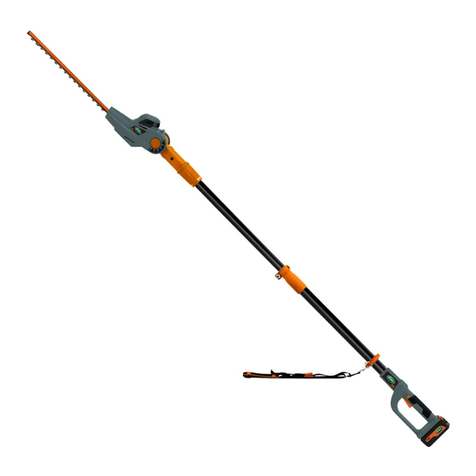
Scotts
Scotts LPHT11724S User manual
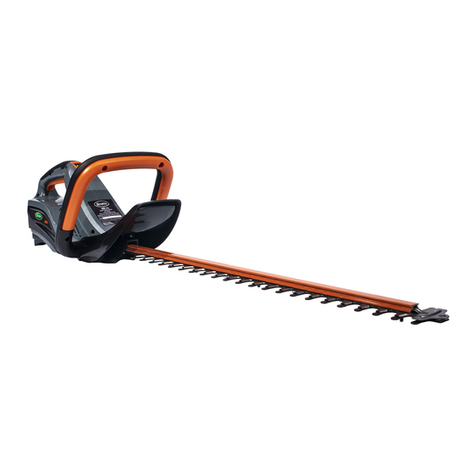
Scotts
Scotts LHT12440S User manual

Scotts
Scotts LHT12462S User manual
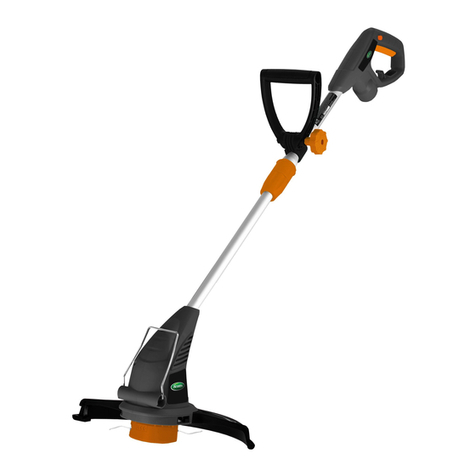
Scotts
Scotts ST00213S User manual
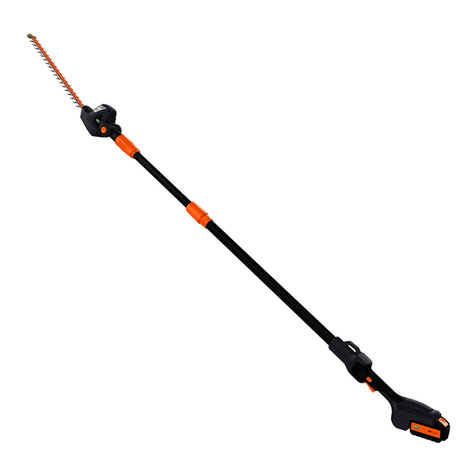
Scotts
Scotts LPHT12122S User manual

Scotts
Scotts LHT12224S User manual
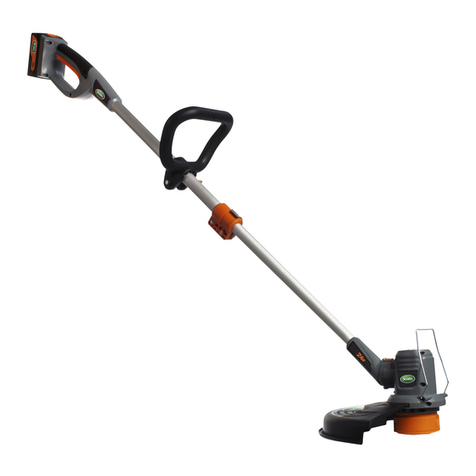
Scotts
Scotts LST01324S User manual
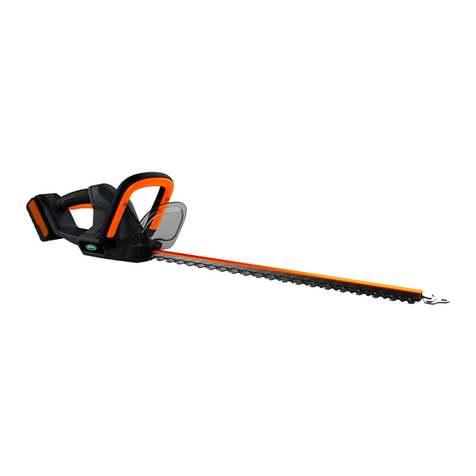
Scotts
Scotts LHT12220S User manual
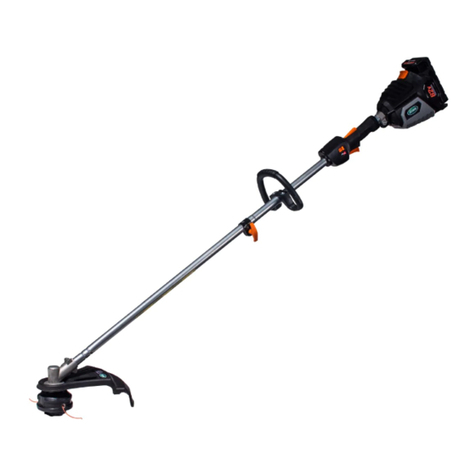
Scotts
Scotts LST01562S User manual
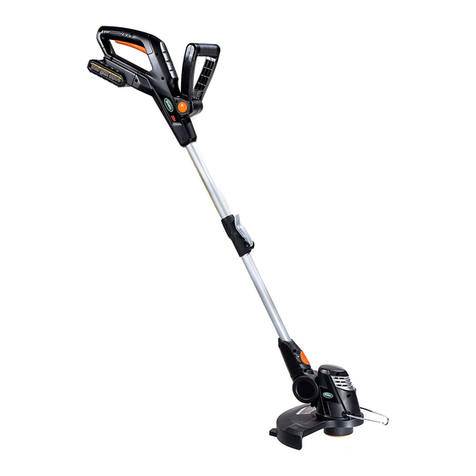
Scotts
Scotts LST02012S User manual
